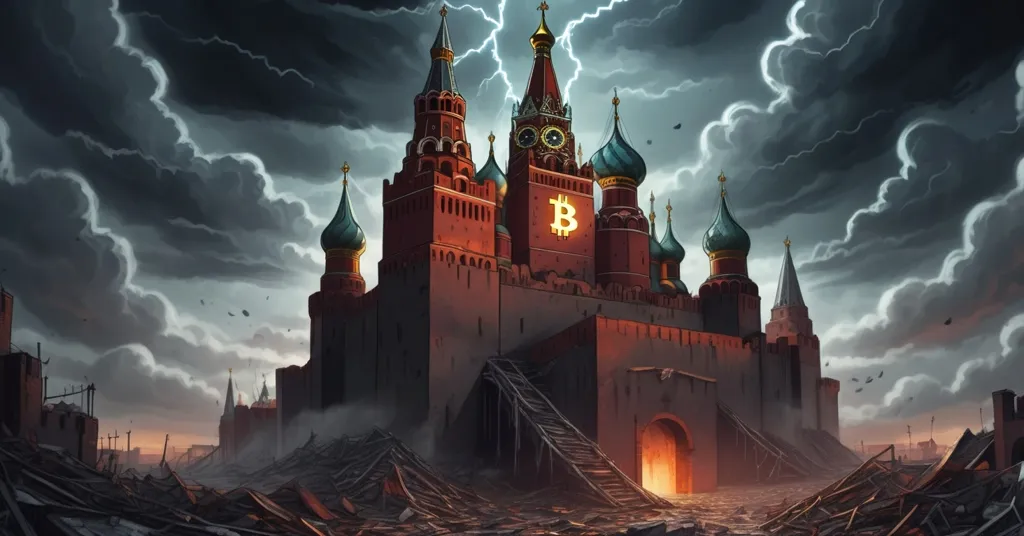Russia’s Fiscal Crisis: Could Bitcoin Be the Ultimate Lifeline?

Russia’s Fiscal Collapse: A Perfect Storm for Crypto Adoption?
Russia’s economy is in deep trouble, hammered by crashing oil prices, ballooning war costs, and growth forecasts that are barely a pulse. The Kremlin’s latest 2026 budget paints a dire picture of deficits and desperation, raising a critical question for our community: could Bitcoin and decentralized finance become a lifeline for a nation choked by sanctions and state overreach?
- Deficit Disaster: A 4.6 trillion ruble ($54.8 billion) shortfall projected for 2026, the fifth straight year of fiscal bleeding.
- War Over Welfare: Ukraine conflict spending trumps social programs, draining national coffers.
- Crypto’s Chance: With taxes soaring and sanctions biting, Bitcoin in Russia could emerge as a tool for financial sovereignty.
Russia’s Fiscal Freefall
The financial outlook from Moscow is grim, and the numbers don’t lie. The Finance Ministry has rolled out a 2026 budget projecting a deficit of 4.6 trillion rubles, or 1.6% of GDP. To put that in perspective, imagine your household spending way more than you earn each year—that’s a deficit, and as a chunk of GDP (the total economic output), it’s like overspending 1.6% of your entire annual income. Spending is set at 44.9 trillion rubles, up 2% from earlier estimates, while revenues crater to 40.3 trillion rubles, a 4% drop. Even worse, the 2025 deficit has been revised from a manageable 1.2 trillion rubles to a staggering 3.8 trillion, now pegged at 2.6% of GDP. Prime Minister Mikhail Mishustin shrugs it off as “acceptable,” but let’s call it what it is: a slow-motion trainwreck.
What’s driving this mess? Two brutal forces are at play. First, oil and gas revenues—Russia’s economic backbone—have collapsed. Global price slumps and Western sanctions since the 2022 Ukraine invasion have gutted export earnings, as detailed in reports on the oil slump and weak GDP growth deepening Russia’s fiscal troubles. Second, war spending is a black hole. For 2025, total expenditure hits 42.3 trillion rubles (19% of GDP), with a mid-year boost of 829 billion rubles just for the conflict. That’s more than what’s allocated to social programs like healthcare or education. Meanwhile, GDP growth forecasts have been slashed to a pitiful 1% for 2025 (down from a rosy 2.5%) and 1.3% for 2026. Think of it as a family budget where your income growth crawls while bills pile up—except this family is a nation with tanks to fund.
Tax Hikes and Public Squeeze
How does Russia plan to patch this gaping hole? By squeezing its people and businesses dry. Starting in 2025, the value-added tax (VAT)—a consumption tax slapped on goods and services at every stage, ultimately hitting consumers—jumps from 20% to 22%. This is expected to haul in 1.19 trillion rubles, but it means everything from bread to gadgets gets pricier. The VAT threshold for businesses also plunges from 60 million rubles in revenue to just 10 million, roping in smaller players who were previously exempt. Add a new 5% tax on certain gambling companies and the scrapping of insurance premium exemptions for small and medium-sized enterprises, now stuck with a flat 30% rate. Oh, and borrowing? That’s spiking by 2.2 trillion rubles by the end of 2025 just to keep the lights on.
Finance Minister Anton Siluanov, speaking at a Moscow forum, tried to spin this as a power move:
“We need to make the budget more muscular. We have to respond to any constraints we face.”
Muscular? More like a budget on steroids with no gains in sight. This directly contradicts President Vladimir Putin’s earlier vow not to hike taxes until 2030—a promise now as trustworthy as a shady altcoin’s whitepaper. Picture a small business owner in Moscow, already struggling with sanctions-hit supply chains, now facing this tax avalanche. It’s not hard to see why resentment is brewing. Meanwhile, the National Wellbeing Fund—think of it as Russia’s emergency savings account—has only 4 trillion rubles left in liquid assets (cash or easily sellable holdings). The Bank of Russia is waving red flags, urging cuts to non-war spending, but with the State Duma reviewing this three-year budget plan on September 29, don’t bet on sanity prevailing.
Crypto as a Quiet Rebellion
With traditional financial systems tightening the screws on Russians, many are looking beyond borders—and beyond fiat—for solutions. Bitcoin in Russia could become a critical tool amid sanctions and currency volatility, offering a borderless, censorship-resistant way to store value or move money. Reports since the 2022 sanctions rollout have noted a surge in crypto adoption, with Russians turning to peer-to-peer trading platforms to bypass banking restrictions. Though platforms like LocalBitcoins shut down in 2023, alternatives persist, and underground networks thrive when necessity kicks in. For a citizen watching the ruble wobble and taxes soar, a decentralized asset like Bitcoin isn’t just a speculative play—it’s a hedge against a failing system.
Let’s ground this in context. Russia’s relationship with crypto is a messy one. In 2020, a law recognized cryptocurrencies as property but banned their use as legal tender. By 2021, using crypto for payments was explicitly outlawed, though holding and trading remain in a gray area. Despite the hostility, necessity breeds defiance. Post-sanctions, transaction volumes on crypto exchanges spiked, with some estimates suggesting Russians moved billions into Bitcoin and stablecoins to preserve wealth or settle cross-border deals. This mirrors patterns in places like Venezuela, where economic collapse drove crypto into the mainstream. When your government’s fiscal policy is a dumpster fire, financial sovereignty via blockchain starts looking less like a libertarian pipe dream and more like a practical escape hatch.
For seasoned folks in our space, consider this: Bitcoin’s privacy features, like mixing services or the Lightning Network for off-chain transactions, could help Russians dodge state surveillance. But it’s not just Bitcoin—privacy-focused altcoins like Monero, with stronger anonymity by default, might appeal more to those under a heavy surveillance regime. While I lean toward Bitcoin maximalism, I’ll concede that altcoins fill niches Bitcoin doesn’t, especially when anonymity trumps all. Decentralized finance solutions could redefine how Russians interact with money when the state overreaches.
The Roadblocks to Decentralized Salvation
Before we get carried away with crypto hopium, let’s play devil’s advocate. Bitcoin and blockchain aren’t magic wands for Russia’s woes. Regulatory hostility is a massive hurdle—the Kremlin has toyed with everything from outright bans to tightly controlled crypto mining laws. Just this year, discussions around using digital assets for cross-border payments (versus their own digital ruble) show a state that wants control, not freedom. If adoption spikes, expect harsher crackdowns, not hugs. Then there’s volatility. Bitcoin’s price swings can wipe out savings faster than sanctions, and for every savvy user, there’s a newbie ripe for scams—think phishing attacks or fake exchanges preying on desperation.
Infrastructure is another kicker. Widespread crypto use needs education, internet access, and tech literacy—not exactly abundant in a nation where war spending outpaces public investment. Plus, blockchain isn’t as private as some think. Government-grade analysis tools can trace transactions, especially if users aren’t meticulous with opsec. And let’s not forget systemic issues—Bitcoin can’t fix corruption or replace oil revenue overnight. While decentralized finance solutions shine in chaos, they’re a niche tool, not a mainstream fix. Russians dabbling in crypto might find temporary relief, but they’re also rolling the dice against state pushback and market mayhem.
What’s Next for Russia and Crypto?
Looking ahead, Russia’s fiscal crisis could go one of two ways for crypto. Scenario one: the state doubles down, cracking the whip on Bitcoin and altcoins as threats to the ruble and national control. We’ve seen hints of this with proposals to criminalize unauthorized crypto mining. Scenario two: necessity forces a reluctant pivot. If sanctions tighten further and traditional finance fails, the Kremlin might quietly tolerate or even harness crypto for cross-border trade, much like Iran has experimented with Bitcoin to skirt embargoes. Global trends could nudge this along—if major economies warm to digital assets, Russia might follow to stay competitive.
Either way, parallels exist. Venezuela’s hyperinflation drove Bitcoin adoption despite state resistance, with citizens using it for remittances and daily trades. Could Russia follow suit if its fiscal collapse accelerates? It’s a long shot, but not impossible. The bigger question is whether public discontent—fueled by tax hikes and slashed social spending—ignites faster than blockchain solutions can scale. For now, Russia’s budget battles are a petri dish for testing decentralized ideals against centralized power. The outcome could either validate Bitcoin’s promise or underscore its limits.
Key Takeaways and Questions
- What’s fueling Russia’s budget crisis?
A 4.6 trillion ruble deficit for 2026 is driven by massive Ukraine war costs, plummeting oil and gas revenues from price slumps and sanctions, and weak GDP growth forecasts of 1% for 2025 and 1.3% for 2026. - How is Russia tackling its fiscal shortfall?
The government is hiking VAT to 22%, slashing business tax thresholds, levying new taxes on gambling firms, ending exemptions, and borrowing 2.2 trillion rubles by 2025 to bridge the gap. - Why does Russia’s economic trouble matter to crypto fans?
Fiscal strain and sanctions often spur crypto adoption as people seek alternatives for wealth preservation or bypassing restrictions, positioning Russia as a potential hub for Bitcoin and blockchain use. - Can Bitcoin in Russia bypass sanctions effectively?
While Bitcoin offers a decentralized way to move money across borders, regulatory crackdowns and traceability risks mean it’s a partial workaround, not a foolproof solution. - What are the risks of using cryptocurrency in Russia?
Users face state hostility, potential bans, price volatility, scams targeting the desperate, and limited infrastructure, making crypto a risky bet despite its allure. - Could altcoins play a role alongside Bitcoin?
Privacy coins like Monero might attract Russians needing anonymity under surveillance, filling a niche Bitcoin doesn’t fully cover in high-risk environments. - Is Russia’s fiscal strategy doomed to fail?
Heavy debt, tax hikes, and a near-empty National Wellbeing Fund signal long-term instability, especially as war spending overshadows social needs, risking public unrest.
Russia’s fiscal nightmare is a stark reminder of how fragile centralized economies can be when tied to volatile commodities and geopolitical gambles. As the Kremlin tightens its grip with taxes and debt, the case for decentralized alternatives like Bitcoin grows louder—though the path is fraught with pitfalls. If this crisis accelerates crypto adoption, could Russia unintentionally become a proving ground for financial freedom, or will it serve as a cautionary tale of state pushback crushing innovation? The stakes couldn’t be higher, and the world is watching.



